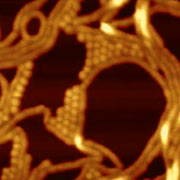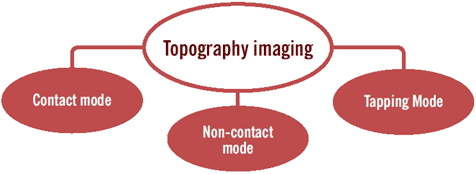Topography imaging at the nanoscale is one of the main scopes of AFM. Analysis of chemical composition and structure of various blends, block-copolymers, fibres, crystallites and single molecules is primarily based on visualization of topography data. Different processes like crystallization/melting, wetting/dewetting, diffusion, adsorption, self-assembly and chemical reactions can also be visualized using topography scans.
| Fig. 1. Height image showing the coexistence of spherical and cylindrical micelles of PS-b-PI block-copolymers in n-heptane.* Scan size 1.2x1.2µm. |
 |
Basically, there are three different AFM modes used for topography imaging, which are non-contact mode, contact mode and tapping mode.

Tapping mode
Tapping mode is widespread for its ability of non-destructive high-resolution imaging of soft and fragile samples in ambient conditions. The success of the experiment depends not only on a correctly chosen AFM probe but to a large extent on an optimal imaging routine. A minimal tip-sample force, properly adjusted feedback and an appropriate scan rate are the combination of important parameters for the most precise topographic imaging. The minimization of the tip-force in tapping mode is achieved by choosing a set-point amplitude (Asp) as close as possible to the amplitude of the free-oscillating AFM probe (A0).
Due to a number of instrumental imperfections (stability of the laser, variations in the mechanical coupling between the AFM probe and its holder, thermal drift, etc) it is rather difficult to ensure high stability of the amplitude and to conduct imaging say at Asp = 0.99A0. These imperfections lead to a slow change of the imaging contrast during scanning. Thermal drift is one of the important factors influencing imaging in amplitude modulation modes, such as tapping mode. High quality factors of the AFM probes place time restrictions on the feedback mechanism and imaging in tapping mode should be conducted relatively slowly with scan rates not largely exceeding 1Hz. These rates are recommended for imaging areas below 1µmX1µm, and the rates are even smaller for scanning larger areas.
In many cases, moderately stiff AFM cantilevers of the 14 series (~1N/m) AFM probes with AFM tip radius ~8nm can be used, which provide good-quality images for a broad variety of samples. The choice of the AFM probe tip is determined by the resolution needed in the experiment. When imaging conditions are optimized, sequential images of the same area are almost identical.
It might also be useful at the end of the studies of the particular area to make a final scan on a large area that includes the location where multiple scans have been performed. In some cases it can be found that imaging of the smaller area has left a "window" seen in the large scan. This would be a strong indication that tip-force should be minimized further either by choosing smaller A0 (still keeping Asp close to A0) or by taking softer AFM probes (18 series or even the softer 19 series).
Tapping mode in liquid requires AFM cantilevers with a relatively low resonance frequency. It is generally recommended to use uncoated AFM cantilevers in liquids or AFM probes with overall chemically stable Cr-Au coating having AFM tip radius about 50nm.
Contact mode
Contact mode is a high-speed AFM technique, which is mainly used to image hard surfaces when the presence of lateral forces is not expected to modify the morphological features. Conventional contact mode AFM cantilevers for use in air have a normal spring constant of 0.18N/m. The choice of resolution is limited to Standard Contact Mode AFM probes HQ:CSC17/Al BS and DLC coated Contact Mode AFM probes HQ:CSC17/HARD/Al BS AFM probes.
Though the back side coating is stable in air and some fluids like water and ethanol, it dissolves readily in caustic alkali solutions to give aluminum hydroxide. Uncoated AFM probes or AFM probes with overall chemically inert Cr-Au coating having larger AFM tip radius about 35nm are recommended for using in aggressive liquid media.
Non-contact mode
In non-contact mode the tip-sample interaction is minimized. Ultrahigh vacuum (UHV) conditions are essential in this mode as small amplitudes of oscillation and small tip-sample distance are used to enhance the sensitivity to short-range tip-sample forces. High spring constant of 20-100N/m is required to avoid AFM tip sticking to the sample surface at small amplitudes. AFM cantilevers with higher resonance frequency are preferable as they are faster and less noisy, use low-frequency AFM probes only if your system does not support AFM probes with short AFM cantilevers.
* LaRue, I.; Adam, M.; Pitsikalis, M.; Hadjichristidis, N.; Rubinstein, M.; Sheiko, S.S. "Reversible Morphological Transitions of Polystyrene-b-Polyisoprene Micelles" Macromolecules 39, 309-314 (2006).

